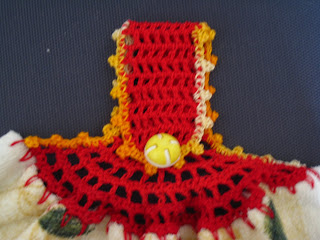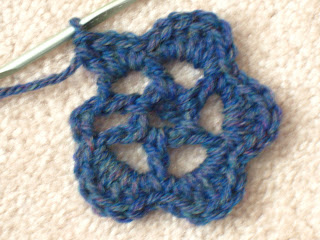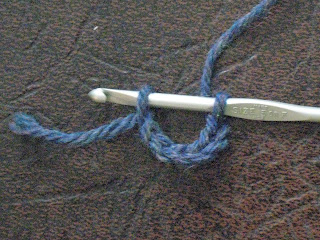
The terry cloth dish cloth hanger is now finished. It used a couple different mesh patterns plus a buttonhole plus a picot edging. Here is a pic.
Meshes are part of a type of crocheting called
filet crochet.
Two basic meshes in filet crocheting are the open or filet mesh and the block or solid mesh. The American Thread Company booklet shows how to do both of these basic meshes.
The picture at the top is of an
open or filet mesh. To start off this mesh from a chain base, first chain 8 plus a multiple of 3 sts. Then, quoting from the booklet, "work the first dc in 8th ch from hook, * ch 2, skip 2, dc in next st, repeat from *. Succeeding rows, ch 5 to turn and dc in dc, * ch 2, dc in next dc, repeat from *."
 The 7 unworked chain sts at the beginning of the first row represent 2 ch sts for the top and 2 for the bottom of the first mesh hole and 3 ch sts to replace a dc at the beginning of the row. The ch 5 at the beginning of subsequent rows is 3 ch sts in place of a dc plus 2 ch sts for the top of the mesh hole.
The 7 unworked chain sts at the beginning of the first row represent 2 ch sts for the top and 2 for the bottom of the first mesh hole and 3 ch sts to replace a dc at the beginning of the row. The ch 5 at the beginning of subsequent rows is 3 ch sts in place of a dc plus 2 ch sts for the top of the mesh hole.The picture at the bottom has
block or solid meshes filling in some of the open mesh squares. To work the mesh pictured from a chain, first chain a multiple of 6 sts. Then, work a dc in 4th ch from hook, dc 3, * ch 2, skip 2, dc 4, repeat from *.
(The ch 3 at the beginning of the row counts as a dc.) Note that for the 4 dc blocks, the first and last dc's are made in the top of a dc and the middle 2 dc's are made in a chain space.For subsequent rows, alternate:
Ch 3, skip 1st dc, dc 2, * dc 4, ch 2, skip 2, repeat from *, end with dc 7
(or, alternatively, for an open mesh at the beginning and end of the row, ch 5, skip 1st 3 dc's, * dc 4, ch 2, skip 2, repeat from *, end with dc 1.Ch 3, skip 1st dc, dc 3, * ch 2, skip 2, dc 4, repeat from *.

It's easy to design your own filet crochet patterns and mesh patterns. Get some graph paper and shade in the squares that you want as chain spaces.
Here's a link to a traditional filet design, a spider.
Here's a diamond mesh design that I made up years and years ago for a throw (in worsted weight yarn). The rows are:
Row 1: Ch 3, * dc 2, ch 1, skip 1, dc 2, repeat from *.
Row 2: Ch 3, * dc 1, ch 1, skip 1, dc 1, ch 1, skip 1, dc 2, repeat from *.
Row 3: Ch 3, * ch 1, skip 1, dc 3, ch 1, skip 1, dc 1, repeat from *.
Row 4: Ch 3, *dc 2, ch 1, skip 1, dc 2, ch 1, skip 1, repeat from *, but last time dc 1 instead of ch1, skip 1.
Row 5: Same as Row 3.
Row 6: Same as Row 2.
A final note: For each of these rows, I've started out with a ch 3 as a replacement for a dc. There is another equally good (and sometimes better) way to start rows of dc's. --- Ch 2, then dc in the first not the second stitch, as we had been doing. The ch 2 is not a replacement for a dc. It just gives a more interesting edge. This ripple afghan pattern has an edge like this. It's done in sc, and so there is a ch 1 at the beginning of each row.
 A dc is twice the height of a sc. And so, for a smoother curve to the petal, it would be nice to have a stitch that is about halfway in height between the two. That stitch is the half double crochet. At the right is a description of the stitch from the American Thread Company booklet. It's called a short double crochet there. (The British call the stitch a half triple crochet.)
A dc is twice the height of a sc. And so, for a smoother curve to the petal, it would be nice to have a stitch that is about halfway in height between the two. That stitch is the half double crochet. At the right is a description of the stitch from the American Thread Company booklet. It's called a short double crochet there. (The British call the stitch a half triple crochet.) The second round is (paraphrasing the directions from the booklet):
The second round is (paraphrasing the directions from the booklet):











